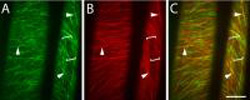Formation of cellulose fibers tracked for the first time

Molecules of cellulose synthase, the enzyme that produces cellulose, follow microtubule “tracks” in growing plant cells. Each image in this set consists of 30 frames, taken at 10 second intervals ...
However, recent work from the Carnegie Institution’s Department of Plant Biology and Stanford University describes the first real-time observations of cellulose fiber formation. The research, published in the April 20 online issue of Science Express, provides the first clear evidence for a functional connection between synthesis of the cell wall and an array of protein fibers–called microtubules–that help to shape growing plant cells from the inside.
“The more we understand about cellulose, the easier it will be to modify it,” said Chris Somerville, director of the Carnegie department. “With this knowledge, we are one step closer to designing energy-rich biofuel crops and improved fiber crops.”
Cellulose fibers make up a significant portion of the dry weight of most plants. Because the fibers can be broken down into the sugar glucose, which can then be converted into ethanol and other biofuels, there are huge incentives to learn more about how plants produce and modify the molecule. Cellulose is also the main constituent of cotton, paper, wood, and animal feeds such as hay.
Somerville, along with colleague David Ehrhardt and Stanford graduate student Alex Paredez, engineered plants to produce a fluorescent version of cellulose synthase, the enzyme that creates cellulose fibers. They also included a fluorescent version of tubulin, the protein from which microtubules are built. Using an imaging technique that can track the motion of single fluorescent molecules, the researchers found that cellulose synthase moves along “tracks” defined by the microtubules. When the microtubule tracks were disrupted with specific drugs, the cellulose synthase molecules kept moving, but they followed different, less directed patterns.
“Many scientists had suspected a relationship between cellulose synthase and microtubules, but the exact nature of the interaction was hard to pinpoint,” Ehrhardt said. “The microtubules act as more than a general scaffold for organizing the cell wall; individual elements of the microtubule array appear to actively direct the pattern of the cellulose fibers. This work should set a long-standing discussion to rest.”
Media Contact
More Information:
http://www.stanford.eduAll latest news from the category: Life Sciences and Chemistry
Articles and reports from the Life Sciences and chemistry area deal with applied and basic research into modern biology, chemistry and human medicine.
Valuable information can be found on a range of life sciences fields including bacteriology, biochemistry, bionics, bioinformatics, biophysics, biotechnology, genetics, geobotany, human biology, marine biology, microbiology, molecular biology, cellular biology, zoology, bioinorganic chemistry, microchemistry and environmental chemistry.
Newest articles

Superradiant atoms could push the boundaries of how precisely time can be measured
Superradiant atoms can help us measure time more precisely than ever. In a new study, researchers from the University of Copenhagen present a new method for measuring the time interval,…

Ion thermoelectric conversion devices for near room temperature
The electrode sheet of the thermoelectric device consists of ionic hydrogel, which is sandwiched between the electrodes to form, and the Prussian blue on the electrode undergoes a redox reaction…

Zap Energy achieves 37-million-degree temperatures in a compact device
New publication reports record electron temperatures for a small-scale, sheared-flow-stabilized Z-pinch fusion device. In the nine decades since humans first produced fusion reactions, only a few fusion technologies have demonstrated…





















